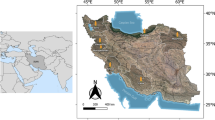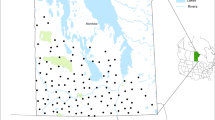Abstract
The low availability of high-quality meteorological data resulted in the development of synthetic meteorological data generated by satellite or data interpolation, which are available in grids with varying spatio-temporal resolution. Among these different data sources, NASA/POWER and DailyGridded databases have been applied for crop yield simulations. The objective of this study was to evaluate the performance of these two datasets, in different time scales (daily, 10-day, monthly, and annual), as input data for estimating potential (YP) and attainable (YA) maize yields, using the FAO Agroecological Zone crop simulation model (FAO-AEZ), properly calibrated and validated. For that, daily weather data from ten Brazilian locations were collected and compared to the data extracted from NASA/POWER and DailyGridded systems and later applied to estimate the potential and attainable maize yields. DailyGridded data showed a better performance than NASA/POWER for all weather variables and time scales, with confidence index (C) ranging from 0.52 to 0.99 for the former and from 0.09 and 0.99 for the latter. As a consequence of that, DailyGridded data was better than NASA/POWER to estimate maize yields with estimates close to those obtained with observed data, with a lower mean absolute errors (< 30 kg ha−1) and a higher confidence index (C = 0.99).




Similar content being viewed by others
Change history
20 December 2019
The original article was published with errors found in the “Material and Methods” section, as well as the “Results and Discussion” section and Tables 5 and 6.
References
Aggarwal PK (1995) Uncertainties in crop, soil and weather inputs used in growth models: implications for simulated outputs and their applications. Agric Syst 48:361–384. https://doi.org/10.1016/0308-521X(94)00018-M
Allen RG, Pereira LS, Raes D, Smith M (1998) Crop evapotranspiration: guidelines for computing crop water requirements. Roma, FAO (Irrigation and Drainage Paper 56).
Bai J, Chen X, Dobermann A, Yang H, Cassman KG, Zhang F (2010) Evaluation of NASA satellite- and model-derived weather data for simulation of maize yield potential in China. Agron J 102:9–16. https://doi.org/10.2134/agronj2009.0085
Bates BC, Charles SP, Hughes JP (1998) Stochastic downscaling of numerical climate model simulations. Environ Model Softw 13:325–331. https://doi.org/10.1016/S1364-8152(98)00037-1
Battisti R, Bender FD, Sentelhas PC (2018) Assessment of different gridded weather data for soybean yields simulations in Brazil. Theor Appl Climatol 135:237–247. https://doi.org/10.1007/s00704-018-2383-y
Bender FD 2017, Climate change and its impact on maize yields and crop management strategies to minimize yield losses in different Brazilian regions. University of São Paulo. PhD. Thesis. (In Portuguese).
Bender FD, Sentelhas PC (2018) Solar radiation models and gridded databases to fill gaps in weather series and to project climate change in Brazil. Adv Meteorol 2018:1–15. https://doi.org/10.1155/2018/6204382
Bengtson L, Andrae U, Aspelien T, Batrak Y, Calvo J, Rooy W, Gleeson E, Hansen-Sass B, Homleid M, Hortal M, Ivarsson K, Lenderink G, Niemela S, Nielsen KP, Onvlee J, Rountu L, Samuelson P, Munoz DS, Subias A, Tijm S, Toll V, Yang X, Koltzow MO (2017) The HARMONIE–AROME Model Configuration in the ALADIN–HIRLAM NWP System. Monthly Weather Rev 145:1919–1935. https://doi.org/10.1175/MWR-D-16-0417.1
Brasil (1981) Ministério das Minas e Energia. Secretaria Geral. Projeto RADAMBRASIL. Rio de Janeiro: Levantamento de Recursos Naturais, 25, 29, 31.
Camargo AP, Sentelhas PC (1997) Avaliação do desempenho de diferentes modelos de estimativa de evapotranspiração potencial no Estado de São Paulo, Brasil. Rev Bras Agrometeorol 5:89–97
Charles SP, Bates BC, Smith IN, Hughes JP (2004) Statistical downscaling of daily precipitation from observed and modelled atmospheric fields. Hydrol Proc 18:1373–1394. https://doi.org/10.1002/hyp.1418
de Wit AJ, van Depien CA (2008) Crop growth modelling and crop yield forecasting using satellite-derived meteorological inputs. Int J Appl Earth Observ Geoinf 10:414–425. https://doi.org/10.1016/j.jag.2007.10.004
Doorenbos J, Kassam AH (1979) Yield response do water. Rome, FAO (Irrigation and Drainage Paper 33).
Duarte YCN (2018) Maize simulation models and their use to determine yield gaps and yield forecast in Brazil. University of São Paulo. MSc. Thesis. (In Portuguese).
Fancelli AL, Dourado Neto D (2000) Produção de milho. Guaíba: Editora Agropecuária.
Hargreaves GH, Samani ZA (1985) Reference crop evapotranspiration from temperature. Appl Eng Agric 1:96–99. https://doi.org/10.13031/2013.26773
Jimenes PA, Hacker JP, Dudhia J, Haupt SE, Ruiz-Arias JA, Gueymard CA, Thompson G, Eidhammer T, Deng A (2016) WRF-Solar: An augmented NWP model for solar power prediction. Model description and clear sky assessment. BAMS, 2016:1249–1264. https://doi.org/10.1175/BAMSD-14-00279.1
Lorenc AC, Bowler NE, Clayton AM, Pring SR (2015) Comparison of Hybrid-4DEnVar and Hybrid-4DVar Data Assimilation Methods for Global NWP. Monthly Weather Rev 143:212–229. https://doi.org/10.1175/MWR-D-14-00195.1
Manfron PA, Dourado Neto D, Pereira AR, Bonnecarrère RAG, Medeiros SLM, Pilau FG (2003) Modelo do índice de área foliar da cultura do milho. Rev Bras Agrometeorol 11:333–342
Monteiro LA (2015) Sugarcane yield in Brazil: a crop modelling approach. University of São Paulo. Ph.D. Dissertation. 130p. 2015.
Monteiro LA, Sentelhas PC, Pedra GU (2018) Assessment of NASA/POWER satellite-based weather system for Brazilian conditions and its impact on sugarcane yield simulation. Int J Climatol 38:1571–1581. https://doi.org/10.1002/joc.5282
Pereira AR, Angelocci LR, Sentelhas PC (2002) Agrometeorologia: Fundamentos e aplicações práticas. Guaíba: Editora Agropecuária.
Plummer N, Allsopp T, Lopez JA (2003) Guidelines on Climate Observation Networks and Systems. WMO/TD N. 1185
Rivington M, Matthews KB, Bellocchi G, Buchan K (2006) Evaluating uncertainty introduced to process-based simulation model estimates by alternative sources of meteorological data. Agric Syst 88:451–471. https://doi.org/10.1016/j.agsy.2005.07.004
Stackhouse PWJ, Westberg D, Hoell JM, Chandler WS, Zhang T (2015) Prediction of world-wide energy resource (POWER)—Agroclimatology methodology—(1.0° latitude by 1.0° longitude spatial resolution). Hampton, NASA Langely Research Center.
Thornthwaite CW, Mather JR (1955) The water balance. Publications in Climatology. New Jersey: Drexel Institute of Technology.
van Wart J, Grassini P, Cassman KG (2013) Impact of derived global weather data on simulated crop yields. Glob Chang Biol 19:3822–3834. https://doi.org/10.1111/gcb.12302
van Wart J, Grassini P, Yang H, Claessens L, Jarvis A, Cassman KG (2015) Creating long-term weather data from thin air for crop simulation modeling. Agr Forest Meteorol 209-210:49–58. https://doi.org/10.1016/j.agrformet.2015.02.020
Voyant C, Muselli M, Paoli C, Nivet M (2012) Numerical weather prediction (NWP) and hybrid ARMA/ANN model to predict global radiation. Energy 39:341–355. https://doi.org/10.1016/j.energy.2012.01.006
White JW, Hoogenboon G, Stackhouse PWJ, Hoel JM (2008) Evaluation of NASA satellite and assimilation model-derived long-term daily temperature data over the continental US. Agr Forest Meteorol 148:1574–1584. https://doi.org/10.1016/j.agrformet.2008.05.017
White JW, Hoogenboom G, Wilkens PW, Stackhouse PWJ, Hoel JM (2011) Evaluation of satellite-based, model-derived daily solar radiation data for the continental United States. Agron J 103:1242–1251. https://doi.org/10.2134/agronj2011.0038
Willmott CJ (1981) On the validation of models. Phys Geogr 2:184–194
Xavier AC, King CW, Scanlon BR (2016) Daily gridded meteorological variables in Brazil (1980–2013). Int J Climatol 36:2644–2659. https://doi.org/10.1002/joc.4518
Author information
Authors and Affiliations
Corresponding author
Electronic supplementary material
ESM 1
(DOCX 94.3 KB)
Rights and permissions
About this article
Cite this article
Duarte, Y.C.N., Sentelhas, P.C. NASA/POWER and DailyGridded weather datasets—how good they are for estimating maize yields in Brazil?. Int J Biometeorol 64, 319–329 (2020). https://doi.org/10.1007/s00484-019-01810-1
Received:
Revised:
Accepted:
Published:
Issue Date:
DOI: https://doi.org/10.1007/s00484-019-01810-1




